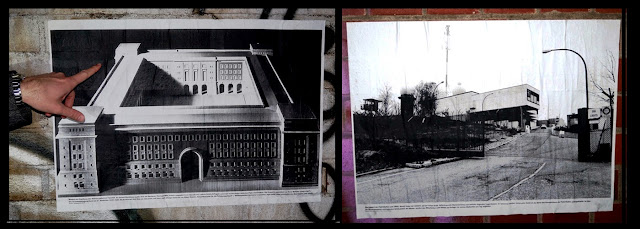First word from my intended sentence returns from the fiberglass shell of the radar dome. In a split second it breaks the waves of the next word, the next, and again, and the words of the others. All these bashed utterances create an inferno of sound waves, desperately seeking ears but instead in vain bounces off the wall. Communication is impossible. But communication wasn't really intended here. No word should ever leave the place. At Teufelsberg listening is the only thing – or it once was.
 |
| One of the ragged domes at Teufelsberg, Berlin's highest mount, and a a small impression of the resort's panorama view. Photo Lars Andreassen. |
I’m standing half an hour
from the Berlin downtown, in Grunewald, on the top of an abandoned building from the
Cold War, in a flayed dome
that once hid the
West – or more precisely America's
– listening devices in the middle of the past GDR (German Democratic Republic). USA’s ears behind enemy lines, deep within East Germany.
Jeffrey
Sachs writes somewhere that Nikita Khrushchev,
the Soviet leader from 1953 to 1964, ”…
viewed West Berlin as a staging post for Western spying and aggression against
the Soviet Union, ”a NATO beachhead and military base against us inside the GDR
[German Democratic Republic].”
A Ragged Design Classic
What the listening equipment in the dome caught and how important it was, we do not know. And we are first to know, when the archives of Teufelsberg is opened in 2022. But the ears of the west in the east had 500,000 East German soldiers to listen to and 400,000 soldiers from GSSD, Gruppe der Sowjetischen Streitkräfte in Deutschland, which was stationed at the frontline of the Cold War.
The spy tower looks like an enlarged version of the famous Bauhaus lamp. It was obvious to everyone, that the hill could hear, but only a small bunch of Americans know how the fine mechanics of the ears were functioning. You have a fantastic view from Teufelsberg over Berlin and surroundings, but the complex itself had almost no eyes. Only in the canteen there were windows.
What the listening equipment in the dome caught and how important it was, we do not know. And we are first to know, when the archives of Teufelsberg is opened in 2022. But the ears of the west in the east had 500,000 East German soldiers to listen to and 400,000 soldiers from GSSD, Gruppe der Sowjetischen Streitkräfte in Deutschland, which was stationed at the frontline of the Cold War.
The spy tower looks like an enlarged version of the famous Bauhaus lamp. It was obvious to everyone, that the hill could hear, but only a small bunch of Americans know how the fine mechanics of the ears were functioning. You have a fantastic view from Teufelsberg over Berlin and surroundings, but the complex itself had almost no eyes. Only in the canteen there were windows.
Anyone could get close to the outer fence, but they were not supposed to see what
went on inside. Numerous Russian
busses were passing by with photographing
"tourists" during the years of the Cold War. And residents
of West Berlin was skiing down the hill until 1972 when they closed the 400-meter-long slope – they even had a world
Cup there – because electromagnetic radiation from the snow machines disturbed
the sensitive technology
in the inner ear.
 |
| The spy tower reminds me of the famous Bauhauslamp. Photo Lars Andreassen. |
And while the precautions
appears relatively relaxed from the outside,
there was a double fence around the
inner ear, where even the British
employees had to badge ID to get into
the deep of the U.S. military facilities.
We don’t know what they heard on Teufelsberg, and we also do not know what will become of the place. A small group of tenacious people guides visitors through the history up here, our guide, Martin Schaffer, tells us, while they try to raise money to maintain the site, create a monument and a museum of the Cold War.
That evening, as we are visiting with a group of students from Egaa Folk High School, in the afternoon, Deutsche Telekom has rented the abandoned radar station for a gigantic party.
And right now its Berlin's main site for
street art. Empty spray cans, waste, falling ceilings, old machines,
dark and empty door holes, and rusty
barbed wire make up the settings for our afternoon and the evenings coming Telekom
party.
Ruin of rubble
The mound Teufelsberg is 120.1 meters high, the highest place in Berlin. Built on the remains of 2nd World War bombed-out Berlin. All the rubbles that couldn't be used for the city's reconstruction were run out here in the suburbs, where they initially covered the remains of what should have been the University of the World Capital, Germania’s Department of War Technology.
The mound Teufelsberg is 120.1 meters high, the highest place in Berlin. Built on the remains of 2nd World War bombed-out Berlin. All the rubbles that couldn't be used for the city's reconstruction were run out here in the suburbs, where they initially covered the remains of what should have been the University of the World Capital, Germania’s Department of War Technology.
The Nazis worked on their project in Grunewald from 1937 until 1942 but they never finished. And now, on the remains of Hitler’s and his architect Albert Speer's megalomaniac visions, the abandoned towers of the Cold War's victorious power – as a history’s ironic comment – resides.
Text, Lars Andreassen
P.S. If you would like to
visit the place, check it out.






No comments:
Post a Comment